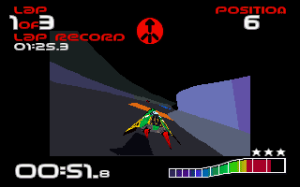The existence of this site, and my ongoing contribution to it, would suggest minimal enthusiasm for the latest gaming technology. Eventually, however, when a five year old game bought from a Steam sale for a few quid is downloaded and launched with moderate excitement, only for frame rates to fall noticeably below a fairly liberal view of what might be considered acceptable, one considers again just how long it takes the dusty old beast to boot up these days, recalls the time that the DVD drive woke up the neighbours, and reasons that it probably is time for an upgrade.
And what better way to test out the new machine than with the very game that prompted its acquisition? As I fired it up, however, excitement once again turned to disappointment, and then, to rage, as impatient tinkering with various settings failed to being about any significant improvement in performance. “The bloody thing ran better on my old machine!” I exclaimed aloud, to no-one in particular.
[It turned out, however, that Rik from the famous gaming website A Force for Good had plugged the monitor into his new PC’s on-board graphics socket instead of the DVI input on the 2GB card. It ran ok after that.]
The whole thing gave me an insight into the travails of the modern gamer, whose difficulties with recent AAA titles such as (checks internet) The Witcher 3 and Batman: Arkham Knight have been well documented. Without trivializing the struggles of frustrated Batmen everywhere, though, it did make me think back to the days when running your game on the minimum spec PC meant you were pretty much guaranteed a visual experience entirely at odds with the one suggested by magazine previews and the back of the game box.
While replaying Doom recently, a combination of its (admirable) ongoing capacity to scare and my own shattered nerves caused me to inadvertently stab at a random key which made the game world more blocky. Yes: more blocky, even, than standard VGA. This is what turning the detail down meant in those days. Adjusting the size of the game window was another option for FPS fans with a 386, with the smallest seeming unfeasible even for the most desperate of gamers.
For a certain generation, the prospect of running racing games in ‘high-res’ SVGA (640×400 for you youngsters) at anything approaching a playable speed was an impossible dream. Screamer’s SVGA mode remained untouched until people started revisiting it years later in the DOSBox era, at which point a number of stability issues were uncovered. Most of the time, though, VGA was acceptable, and playable enough for you to avoid cursing the publisher’s minimum requirements claims as bare-faced lies.
The PC port of Wipeout, though, was a notable exception. Already hamstrung by a control scheme that required a joypad with a number of buttons that exceeded what was actually possible on PC at the time and missing the licensed music of the console version, to even run it in low res fuzziness required a seriously hefty machine. For those on the minimum spec, though, an acceptable speed was accomplished only through significant sacrifice:

Needless to say, this wasn’t what I had in mind when I bought the game.



 Posts
Posts